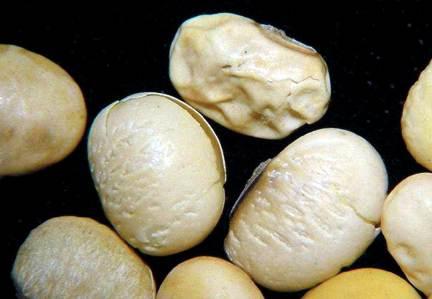December 11, 2018

Source: Iowa State University
By Daren Mueller and Ethan Stoetzer, Iowa State University
With this year’s harvest of soybeans delayed beyond what is considered an ideal window of time, the opportunity for diseases to infect seed pods and in some instances, to the seed itself, was greatly increased. Across the state and the north central region, seed suppliers have reported that this year’s crops of seed soybean are frequently testing positive for the Diaporthe fungus (Phomopsis seed decay), which is resulting in lower than normal germination rates of seed. Seed decay is characterized by cracked, shriveled seed with white chalk-colored mold on the seed surface.
The large amounts of rain that occurred throughout August and September set up this year’s soybean crop to be at a disadvantage to the Diaporthe fungus, which typically infects soybean pods between the R5 (early seeding stage) and R6 (fully seeded pods) growth stages. This is important because only infections initiated in the pods can infect seeds and cause seed decay. As soybean plants reach the R7 growth stage (beginning to mature and dry out), pod colonization declines drastically. Seeds will not become infected once moisture is below 19 percent. However, during periods of wet and warm weather, seed infection and colonization can continue or resume if seed moisture increases to more than 19 percent.
Infected seed will have a lower probability of germination in the following season, when planted. If soil conditions are wetter and cooler than normal, this could drastically impact both the survival and stand count of plants. Diminished seed quality and reduced seed vigor, germination and emergence are all consequences of seed decay. Seed decay can also reduce seed test weight and oil content.
Many dealers will want to have their seed treated with a fungicide to increase the chances of germination and prevent seedling diseases. The Iowa State University Seed Lab is able to test the germination rate of seeds to verify if and what percentage of seeds are infected with the Diaporthe fungus. Depending on the germination rate and incidence of infection, the use of a seed treatment may be warranted.

According to past Iowa State University research, appropriate seed treatments can increase germination rates by 10-15 percent. Given the progress and development of fungicides, germination rates could be further improved, given the right mix. However, winter storage of seed can also increase germination rates, due to the fact that under dry storage conditions, the mycelium of the fungus will die, improving the seed quality. A suggested practice is to dry-store low germ-seeds over winter and re-test the seed in February.
When deciding on which fungicides will be the most effective, consult the Crop Protection Network's guide on seed treatments, which includes a chart rating the efficacy of fungicides for several diseases (consult the Phomopsis section for combating Diaporthe).
It is recommended to not use seed lots with more than 20 percent Diaporthe infection because severely infected or moldy seed will fail to germinate even after being treated.
To be proactive with seed production next year, foliar fungicide applications to protect from seed infection between R3 (beginning pod) and R5 (beginning seed) may reduce seed infection especially in seed production fields. Although fungicide applications may reduce disease and improve seed quality, yield may not be impacted.
You May Also Like




